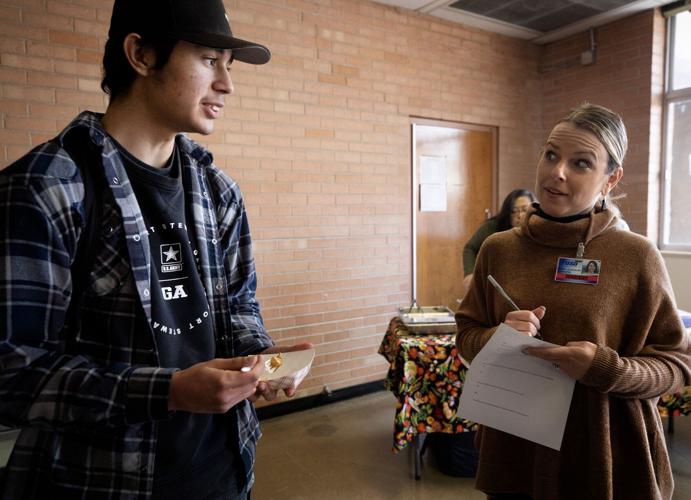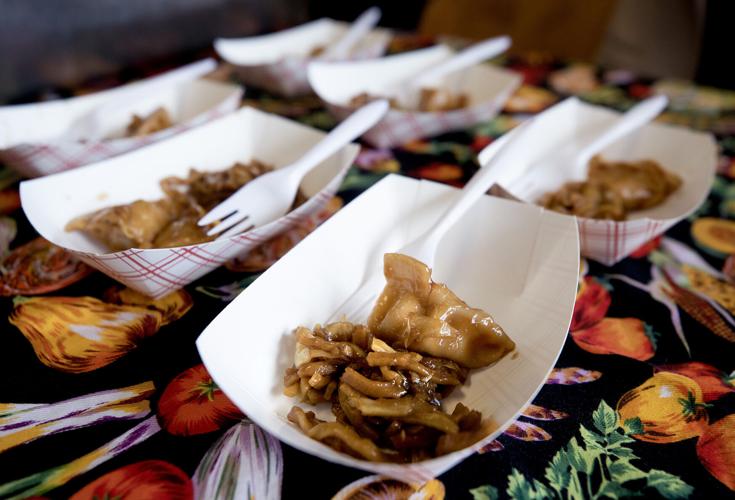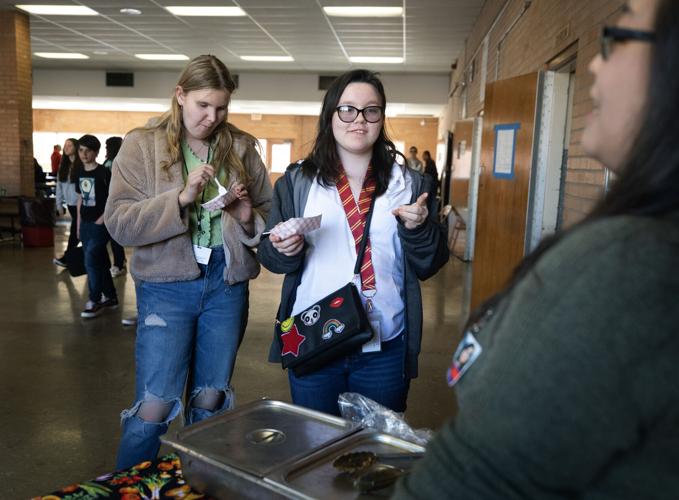As students from Sahuaro High School began flooding into the school cafeteria for lunchtime, the districtтs food services team offered samples of new recipes they were testing.
The students tasted chow mein along with chicken dumplings tossed in a sweet, flavorful sauce, as УлшжжБВЅ Unified School District refreshes cafeteria menus in hopes of getting more to buy the meals.
тWe had streamlined the menu quite a bit the last two school years because of COVID, in terms of the types of services we were doing with grab-and-go, everything being pre-packaged and navigating staffing challenges,т said TUSD Food Services Director Lindsay Aguilar.
Now, the main goal is to тrevamp our menus to go back to offering a lot of the variety and food optionsт the cafeterias had before the pandemic, she said.
The efforts this year also included changing the way the food is presented, such as switching from the typical white foam plates to black plates and bowls that resemble the more modern takeout containers at restaurants.
People are also reading…
The food services team also added themed stations, such as International Favorites, in which students are offered Asian, Italian, Mexican and other types of cuisine.
At Pueblo High School, the team rolled out a pilot program for a smoothie cart, serving freshly made smoothies for breakfast, Aguilar said.
In another example, elementary and K-8 schools got the new option of breaded ravioli with a marinara dipping sauce.
And aside from testing out the new chow mein and dumplings recipes, some students at Sahuaro High also stood in line at the Chicken nт More Chicken food station.
тI will say our тChicken nт More Chickenт station is, pretty much across the board, one of the most popular. The students love chicken in any form, like a spicy chicken sandwich or regular chicken patty sandwich,т Aguilar said.
тWeтve always had pizza on the menu because thatтs a staple favorite,т she added.
Neo Watson and Michael Simmons, both 17-year-old seniors at Sahuaro, said they donтt eat school food very often since the district stopped offering the meals for free. The two usually bring their own lunch from home and will only pay for school meals they really enjoy, such as pizza.
тIf it was free, I might eat school food every day,т Watson said.
During the pandemic, the federal government allowed public school districts to operate under a free meal program, meaning that all TUSD students received their breakfast and lunch meals at no personal cost, Aguilar said.
At that time, lunch participation in TUSD high schools was at its highest, with about 65% of students eating school meals.
But, she said, the federal government did not extend that waiver once it expired, so students had to begin paying for their meals at the start of the 2022-2023 school year.
Now, student participation at lunchtime is at about 45%.
More appetizing, still nutritious
The chow mein and dumpling samples handed out at Sahuaro received positive feedback, and some students returned to the sampling station to get second plates.
Kalia Davis, 17, and Sanaa Comer, 16, both juniors at Sahuaro, said theyтre not huge fans of school food in general. While Comer avoids eating school food altogether by bringing her motherтs home-cooked meals everyday for lunch, Davis only sticks to one item on her schoolтs menu.
тI only get a chicken salad, though, because the other food is not good. It just doesnтt look appetizing to me,т Davis said.
But she said some of TUSDтs new presentations were definitely helping the meals look more appealing.
тThe presentation matters a lot when it comes to food because if it doesnтt look good, then Iтm probably not going to eat it. Thatтs why I bring lunch from home,т Comer said.
And on this particular day, the two students enjoyed the new food option.
тI liked it a lot. Iтve never seen something like this in our school lunch, so itтs something very different. This is something that Iтd eat at home,т Comer said.
Dulce Guzman, a 25-year-old dietetic intern with TUSD Food Services, was the master behind the chow mein and dumpling sauce recipes. She said she was relieved the students liked the meals she helped create.
Prior to holding the student taste test, the food services team held its own sampling, reviewing the meal based on appearance, taste, texture and overall quality.
Guzman said she received specific instructions to create a chow mein recipe after the district received premade whole-grain noodles. That meant mixing the noodles with vegetables and creating the flavor to bring all the ingredients together.
She also had to consider monetary and nutritional instructions as she worked on her recipes. Aguilar said TUSD Food Services is required to adhere to requirements set by the National School Breakfast and Lunch Program of the U.S. Department of Agriculture.
Those guidelines include minimum requirements of whole grain, protein, fruits and vegetables, as well as restrictions on sodium and fat.
тI was very nervous about the sodium, but Iтm under. The other thing was the budget. I only had $2 to spend per plate and Iтm under right now. I think itтs about $1.50 per plate,т Guzman said of her chow mein recipe.
And now that the new recipes have been well received, Aguilar said it will take about a month to purchase the large volume of ingredients needed. She expects the district will be able to offer the chow mein across all grade levels by the end of April.
тThis is going to do really well. The Asian dishes, in general, do really well,т she said.
Watch now: Superintendent Gabriel Trujillo thanks Vantage West Credit Union for donating more than $27,000 to pay for students' lunch debt from fall 2022. Trujillo talks about what the donation means for families in the district. Video courtesy of TUSD.
Have any questions or news tips about K-12 education in Southern УлшжжБВЅ? Contact reporter Genesis Lara at glara@tucson.com


















